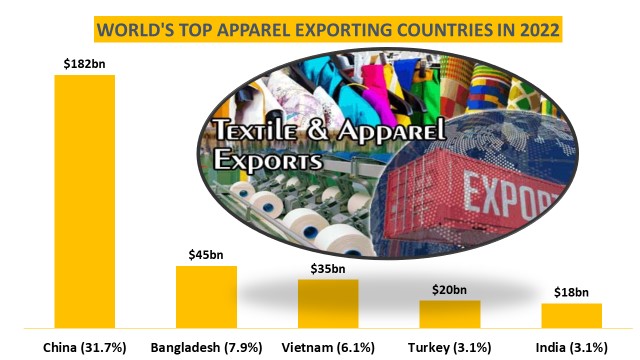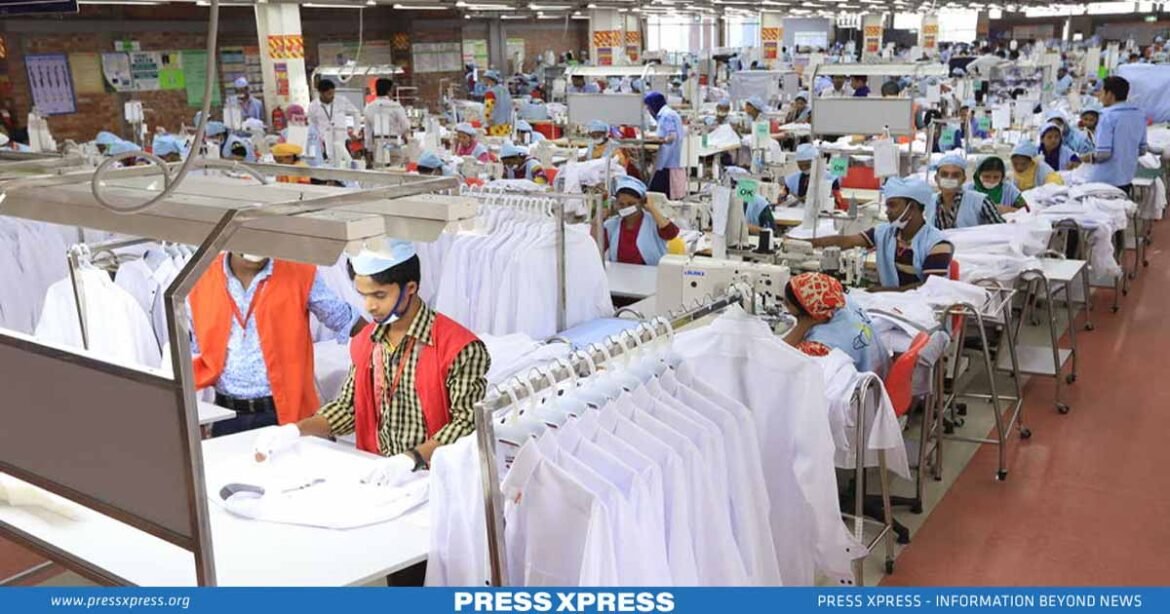Projections indicate that Bangladesh’s textile and garment industry will continue its growth trajectory and is poised to capture more than 10% of the global market share by 2025
– BGMEA
Bangladesh’s textile and apparel sector plays a pivotal role in the nation’s economy and serves as a crucial participant in the worldwide textile and clothing market. For the fiscal year 2021-2022, the country recorded garment exports valued at US $42.613 billion, solidifying its position as the world’s second-largest apparel exporter, according to data from the Export Promotion Bureau.
Furthermore, this sector serves as a significant source of employment and income for Bangladesh, with over 4 million individuals (equivalent to roughly twice the population of New Mexico) employed within it. The Bangladesh Garment Manufacturers and Exporters Association (BGMEA) reported that in the initial eight months of 2022, BD ready-made garment (RMG) exports reached $29.825 billion, marking a notable 38.39% increase compared to the corresponding period in the previous year.
You can also read: Bangladesh sees 45% rise in garment exports to EU
The United States stands as the primary destination for Bangladeshi garment exports, constituting approximately 21.50% of the total exports. The European Union, particularly Spain, Germany, Italy, France, Belgium, and the Netherlands, ranks as the second-largest export destination for BD apparel, followed by the UK and Canada.
Projections indicate that Bangladesh’s textile and garment industry will continue its growth trajectory and is poised to capture more than 10% of the global market share by 2025, as reported by BGMEA. Additionally, the industry stands to gain from the ongoing transformation in global sourcing practices, as an increasing number of countries seek to diversify their supply chains.

A success story: The Bangladeshi garment sector has made remarkable progress
In 2020, Bangladesh slipped from its second-place position as an apparel exporter to Vietnam, recording earnings of $27.47 billion compared to Vietnam’s $29.80 billion. However, Bangladesh reclaimed the second position in 2021, boasting export earnings of $35.81 billion, and successfully defended this position in 2022. Additionally, Bangladesh’s share of the global apparel market has risen to 7.9 percent.
According to the World Statistical Review 2023 by the WTO, Bangladesh secured the second position in garment exports as an individual country, recording $45 billion in apparel exports in 2022, with China maintaining its usual top position. Nevertheless, in this sector, Bangladesh faces a consistent challenge from Vietnam, another Asian nation, which also held onto its third-place position.
The World Trade Statistical Review 2023 report provides an overview of the exports, market share, and growth of the top 10 countries in apparel exports. It is evident that China continued to dominate the global clothing export market in 2022, with apparel exports valued at $182 billion. However, China’s share of global clothing exports decreased from 32.8% in 2021 to 31.7% in the previous year. During the same period, Vietnam remained in third place, with apparel exports totaling $35 billion and a market share of 6.1%. Turkey emerged as the fourth-largest apparel exporter, holding a 3.5% share of the global market and exporting approximately $20 billion worth of apparel in 2022. Following closely behind is India, with a 3.1% market share and apparel exports valued at $18 billion.
The WTO report also disclosed fluctuations in the market share of leading countries in the global apparel export industry. Specifically, the report presented statistics for the years 2000, 2005, 2010, and 2022. Notably, China’s market share has experienced a recent decline. In 2000, China’s contribution to global garment exports stood at 18.2 percent, which then surged to 26.6 percent in 2005 and further rose to 36.6 percent in 2010. However, by 2022, China’s global garment export share had plummeted by 31.7 percent.

Bangladesh’s role in global apparel exports exhibited a slight decline at the onset of the 21st century but is currently on an upward trajectory. In 2000, Bangladesh represented 2.6 percent of global exports, which dipped to 2.5 percent in 2005. Nevertheless, in 2010, Bangladesh’s share rebounded to 4.2 percent. In the most recent year, 2022, Bangladesh accounted for 7.9 percent of global exports.
Promising alternative market
Exports to Japan surged to $754.72 million, marking an impressive year-on-year growth of 42.54% from the previous fiscal year’s figure of $529.46 million. In the fiscal year 2022, Bangladesh achieved a remarkable milestone, earning $1.09 billion through the export of apparel items to Japan.
Furthermore, prominent Japanese ready-made garment (RMG) manufacturers are reallocating the majority of their overseas production from China due to escalating labor costs and stringent zero-Covid policies, offering Bangladeshi exporters a valuable opportunity.
Japan’s total imports of apparel items from global sources in 2021 amounted to $23.83 billion, with Bangladesh capturing a notable market share of 4.58%. Speaking about Japan, BGMEA Director Mohiuddin Rubel emphasized Japan’s longstanding significance as a key destination for Bangladeshi exports, highlighting Japan’s strong purchasing power and its dual importance as an emerging market and a high-value market.
Benefitting from zero-duty trade advantages and competitive pricing, the shipment of apparel items to India has witnessed rapid growth. Bangladesh’s earnings from exports to India between July and December of fiscal year 2022-23 reached $548.87 million, reflecting an impressive year-on-year increase of 49.99% from the $365.95 million recorded during the corresponding period in the previous fiscal year.
Discussing India, Mohiuddin Rubel noted that as India’s socio-economic conditions continue to improve, their production costs are also on the rise, eventually leading them to become more import-oriented.
Furthermore, exports to Australia, South Korea, and Mexico experienced substantial growth, with increases of 29.52% to $516.63 million, 35.66% to $255.49 million, and 51.12% to $186 million, respectively. In 2021, Australia imported apparel items worth $7.8 billion from global suppliers, further highlighting the expanding opportunities for Bangladesh’s apparel industry.
In conclusion, Bangladesh, despite facing increased production costs due to global market slowdowns and rising raw material and energy prices, has managed to maintain its status as the world’s second-largest apparel exporter following China. This achievement is truly motivating. Exporters credit this growth to Bangladesh’s pursuit of value-added products and the redirection of orders from China. Exporters anticipate that exports will continue to expand if they receive essential government support, including consistent energy provision and favorable tax and duty policies .


